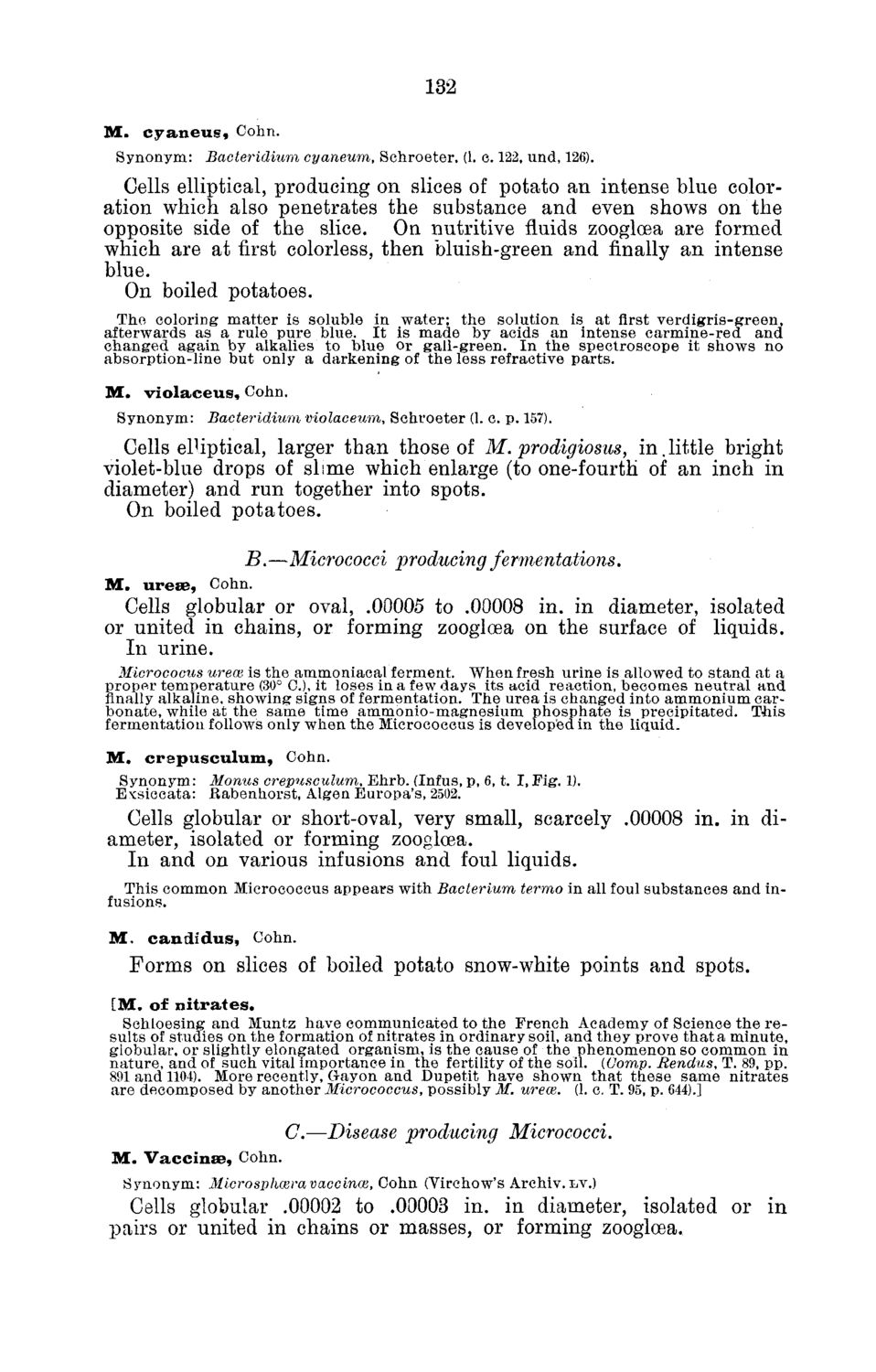| |
| |
Caption: Board of Trustees Minutes - 1882
This is a reduced-resolution page image for fast online browsing.

EXTRACTED TEXT FROM PAGE:
132 M . c y a n e u s , Cohn. Synonym: Bacteridium cyaneum, Schroeter, (1. c. 122, und, 126). Cells elliptical, producing on slices of potato an intense blue coloration which also penetrates the substance and even shows on the opposite side of the slice. On nutritive fluids zooglcea are formed which are at first colorless, then bluish-green and finally an intense blue. On boiled potatoes. The coloring matter is soluble in water; the solution is at first verdigris-green, afterwards as a rule pure blue. It is made by acids an intense carmine-red and changed again by alkalies to blue or gall-green. In the spectroscope it shows no absorption-line but only a darkening of the less refractive parts. M . v i o l a c e u s , Cohn. Synonym: Bacteridium violaceum, Schroeter (1. c. p. 157). Cells elhptical, larger than those of M. prodigiosus, in.little bright violet-blue drops of slime which enlarge (to one-fourth of an inch in diameter) and run together into spots. On boiled potatoes. B.—Micrococci producing fermentations. M . urese, Cohn. Cells globular or oval, .00005 to .00008 in. in diameter, isolated or united in chains, or forming zooglcea on the surface of liquids. In urine. Micrococus urece is the ammoniacal ferment. When fresh urine is allowed to stand at a proper temperature (30° C), it loses in a few days its acid reaction, becomes neutral and finally alkaline, showing signs of fermentation. The urea is changed into ammonium carbonate, while at the same time ammonio-magnesium phosphate is precipitated. This fermentation follows only when the Micrococcus is developed in the liquid. M . c r e p u s c u l u m , Cohn. Synonym: Monus crepusculum, Ehrb. (Infus, p, 6, t. I, Fig. 1). Exsiccata: Babenhorst, Algen Europa's, 2502. Cells globular or short-oval, very small, scarcely .00008 in. in diameter, isolated or forming zooglcea. In and on various infusions and foul liquids. This common Micrococcus appears with Bacterium termo in all foul substances and infusions. M . c a n d i d u s , Cohn. Forms on slices of boiled potato snow-white points and spots. [M. of n i t r a t e s . Schloesing and Muntz have communicated to the French Academy of Science the results of studies on the formation of nitrates in ordinary soil, and they prove that a minute, globular, or slightly elongated organism, is the cause of the phenomenon so common in nature, and of such vital importance in the fertility of the soil. (Comp. Rendus, T. 89, pp. 891 and 1104). More recently, G-ayon and Dupetit have shown that these same nitrates are decomposed by another Micrococcus, possibly M. urece. (1. c. T. 95, p. 644).] C.—Disease producing Micrococci. M . V a c c i n a e , Cohn. Synonym: Microsphceravaccince, Cohn (Virchow's Archiv. LV.) Cells globular .00002 to .00003 in. in diameter, isolated or in pairs or united in chains or masses, or forming zooglcea.
| |